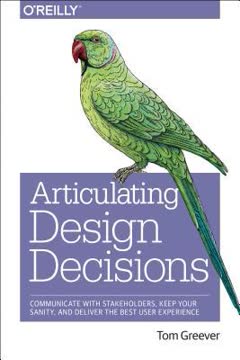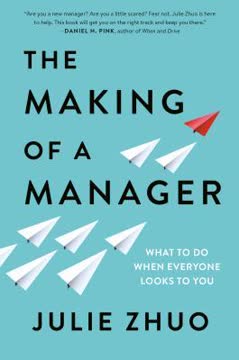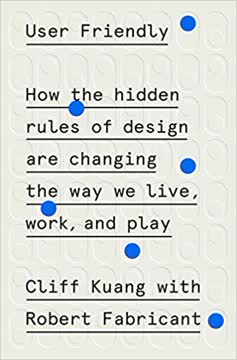Key Takeaways
1. Design is a job: Treat it with professionalism and respect
A designer requires honest feedback and real criticism, and that's not going to happen in a realm where colleagues or clients are worried about crushing the spirit of a magical being.
Professionalism is key. Designers must shed the myth of the "magical creative" and embrace their role as problem-solvers within constraints. This involves:
- Understanding and addressing client goals
- Gathering and analyzing information
- Imposing order and creating novel forms
- Communicating effectively with clients and stakeholders
- Acting as a gatekeeper for ethical design decisions
By treating design as a serious profession, designers can earn respect, deliver better work, and make a positive impact on the world.
2. Cultivate clients through networking and referrals
No one's going to know what you think about unless you write and publish your opinions.
Build your network. The best clients come through referrals, so focus on:
- Being pleasant to work with and doing good work
- Clearly articulating what you do with enthusiasm
- Networking and maintaining relationships
- Being visible through writing and sharing your opinions
- Reflecting well on those who recommend you
Remember that every interaction is an opportunity for business development. Stay connected with past clients and colleagues, as they may become valuable sources of future work.
3. Price your work based on value, not time
Charge as much as you can, deliver an honest value, and never work for free.
Value-based pricing is crucial. Instead of hourly rates, focus on the value your work brings to the client:
- Research the client's business and market landscape
- Understand the potential impact of your work
- Set prices that reflect the value you provide
- Be confident in discussing money and negotiating
- Never work for free or for "exposure"
Present your pricing with confidence, and be prepared to explain how you arrived at your figures. Remember that negotiation is expected, so start from a strong position.
4. Contracts protect both parties and define expectations
A contract is like a prophylactic. It won't keep you from getting fucked, but it may keep you free from additional liabilities down the road.
Contracts are essential. They establish the nature of the relationship and clarify important details:
- Ground rules for working together
- Payment terms and schedules
- Deliverables and deadlines
- Intellectual property rights
- Termination clauses and dispute resolution
Work with a lawyer to develop solid contracts, and be prepared to explain their importance to clients. Remember that contracts don't prevent problems, but they provide a framework for addressing issues when they arise.
5. Present your work with confidence and purpose
If you sit at your desk while someone else presents work to the client, you don't get to complain about the feedback. The failure was yours.
Own your presentations. Presenting your work is a core design skill that involves:
- Having a clear agenda and desired outcome
- Explaining how your choices lead to project success
- Focusing on goals and benefits, not features
- Giving clients permission to provide negative feedback
- Being open to being wrong and learning from criticism
Practice your presentation skills and remember that confidence comes from being prepared and believing in your work.
6. Gather and manage client feedback effectively
Everyone gets the feedback they deserve.
Guide the feedback process. Help clients provide useful input by:
- Setting expectations for feedback early in the project
- Providing clear guidelines on what to focus on
- Discouraging prescriptive feedback
- Organizing feedback into actionable items
- Addressing concerns promptly and professionally
Remember that clients aren't experts in giving design feedback, so it's your job to guide them through the process and interpret their input effectively.
7. Maintain strong relationships with colleagues and collaborators
Act like it's within your power to improve your relationship with other designers and you usually can.
Collaboration is key. Build strong working relationships with:
- Other designers (internal and external)
- Project managers
- Researchers
- Developers and engineers
- Marketers
- Content strategists
Respect each person's expertise and work together towards common goals. Clear communication and defined roles help prevent conflicts and lead to better outcomes.
8. Stick to your process and defend it when necessary
Your process is what enables you to do good work.
Trust your process. Develop and refine a design process that works for you, and:
- Explain your process to clients during the hiring phase
- Stand firm when clients try to break your process
- Be flexible enough to address client anxieties
- Remind clients why they hired you and your process
Remember that your process is what leads to good work, so don't let clients or internal pressures force you to skip important steps or rush through crucial phases.
9. Getting paid: Set clear terms and follow up promptly
The best way to deal with late payments is to keep them from ever being late.
Establish clear payment terms. To ensure timely payments:
- Research the client's payment process
- Negotiate favorable terms (e.g., net 15 or net 30)
- Structure payments around clear milestones
- Invoice promptly and follow up on late payments
- Maintain a professional tone when discussing money
Be prepared to address payment issues calmly and professionally, and don't be afraid to involve your lawyer if necessary.
10. Working with other designers: Collaborate, don't compete
Until designers stop treating each other with the catty competitiveness of contestants in a trashy reality TV show, and start supporting each others' efforts, and figuring out how to complement each others' skill sets, you cannot expect others to take you seriously.
Foster collaboration. When working with other designers:
- Respect their expertise and contributions
- Establish clear roles and responsibilities
- Focus on project goals rather than individual achievements
- Share knowledge and learn from each other
- Avoid undermining or competing with other designers' work
Remember that a rising tide lifts all boats. By supporting and collaborating with other designers, you elevate the entire profession.
11. Career growth: Choose design over management
If you're at a company where the next step up the ladder means managing people more than managing the quality of the design the company is producing, get the hell out of there.
Prioritize design in your career. As you advance:
- Focus on improving your design skills and knowledge
- Seek opportunities to mentor and teach other designers
- Consider starting your own company or becoming a consultant
- Look for roles that allow you to influence design strategy
- Avoid positions that take you away from hands-on design work
Remember that your value as a designer comes from your ability to solve problems and create effective solutions, not from managing people or handling administrative tasks.
Last updated:
FAQ
What's "Design Is a Job" about?
- Focus on Design as Work: "Design Is a Job" by Mike Monteiro emphasizes that design is not just a creative endeavor but a professional service that requires business acumen and client management skills.
- Practical Guidance: The book provides practical advice on how to navigate the business side of design, including working with clients, valuing your work, and getting paid.
- Empowerment for Designers: It aims to empower designers to take control of their careers by understanding the importance of contracts, negotiations, and ethical responsibilities.
- Service Industry Insight: Monteiro highlights the importance of being part of a service industry without becoming a servant, focusing on maintaining professional integrity and respect.
Why should I read "Design Is a Job"?
- Real-World Experience: The author shares insights from his own experiences running a design studio, offering valuable lessons learned from both successes and mistakes.
- Comprehensive Coverage: It covers a wide range of topics essential for designers, from client management to pricing strategies, making it a comprehensive guide for both new and experienced designers.
- Practical Advice: The book is filled with actionable advice that can be immediately applied to improve your design practice and business dealings.
- Confidence Building: It aims to build confidence in designers by providing them with the tools and knowledge needed to assert their value and negotiate effectively.
What are the key takeaways of "Design Is a Job"?
- Design as a Business: Treat design as a business, not just an art form, and understand the importance of contracts, pricing, and client relationships.
- Client Management: Learn how to manage client expectations, communicate effectively, and maintain professional boundaries to ensure successful project outcomes.
- Value Your Work: Charge what your work is worth and never work for free; understand the value you bring to clients and negotiate accordingly.
- Ethical Responsibility: Designers have a responsibility to consider the ethical implications of their work and choose projects that align with their values.
What are the best quotes from "Design Is a Job" and what do they mean?
- "Design is a job." This quote encapsulates the book's central theme that design is a professional service requiring business skills, not just creativity.
- "You are responsible for the work you put into the world." This emphasizes the ethical responsibility designers have in choosing projects that positively impact society.
- "Charge as much as you can, deliver an honest value, and never work for free." It highlights the importance of valuing your work and ensuring fair compensation.
- "A designer who does not present his or her own work is not a designer." This stresses the importance of being able to communicate and advocate for your design decisions.
How does Mike Monteiro suggest handling client relationships?
- Set Clear Expectations: Establish clear terms and expectations from the start, using contracts to define responsibilities and deliverables.
- Communicate Effectively: Maintain open and honest communication with clients, addressing concerns promptly and professionally.
- Manage Feedback: Guide clients on how to provide constructive feedback and ensure it aligns with project goals.
- Build Trust: Develop a relationship based on mutual respect and trust, which can lead to long-term partnerships and referrals.
What advice does "Design Is a Job" give on pricing and getting paid?
- Value-Based Pricing: Charge based on the value your work brings to the client, not just the time it takes to complete.
- Structured Payments: Use commencement fees and milestone payments to ensure steady cash flow and minimize risk.
- Negotiate Terms: Be firm in negotiating payment terms that are fair and sustainable for your business.
- Avoid Working for Free: Never work for free or for exposure; ensure every project has a financial benefit.
How does "Design Is a Job" address the myth of the "magical creative"?
- Debunking the Myth: Monteiro argues that the idea of designers as "magical creatives" is harmful and reduces their role to mere pixel-pushers.
- Focus on Problem-Solving: Designers are problem-solvers who work within constraints to meet client goals, not artists creating for personal expression.
- Professionalism Over Magic: Emphasizes the importance of a methodical, repeatable process over relying on instinct or creativity alone.
- Collaboration and Feedback: Encourages honest feedback and collaboration with clients and stakeholders to achieve successful outcomes.
What does Mike Monteiro say about the importance of contracts?
- Foundation of Trust: Contracts establish the nature of the relationship and build trust between parties by clearly defining roles and responsibilities.
- Protection for Both Parties: They protect both the designer and the client by outlining what happens if things go wrong, including payment terms and deliverables.
- Avoiding Ambiguity: Contracts help prevent misunderstandings and disputes by making implicit assumptions explicit.
- Legal Support: Monteiro advises having a lawyer review contracts to ensure they are strong and fair, providing a safety net for the designer.
How does "Design Is a Job" suggest designers handle feedback?
- Set Guidelines: Provide clients with feedback guidelines to ensure their input is constructive and relevant to the project's goals.
- Encourage Objectivity: Focus feedback on how well the design meets business objectives rather than personal preferences.
- Clarify and Discuss: Organize feedback into actionable items, disagreements, and areas needing clarification, and discuss them with the client.
- Avoid Prescriptive Feedback: Encourage clients to describe problems rather than prescribe solutions, allowing designers to use their expertise to address issues.
What role does ethical responsibility play in "Design Is a Job"?
- Consider Impact: Designers should consider the ethical implications of their work and choose projects that contribute positively to society.
- Client Selection: Be selective about the clients and projects you take on, ensuring they align with your values and ethical standards.
- Responsibility for Outcomes: Acknowledge that designers are responsible for the outcomes of their work and should strive to leave the world better than they found it.
- Ethical Decision-Making: Monteiro encourages designers to make ethical decisions even when faced with financial pressures or challenging situations.
How does "Design Is a Job" address working with other designers and teams?
- Collaboration Over Competition: Emphasizes the importance of collaboration and mutual respect among designers to enhance creativity and problem-solving.
- Clear Roles and Communication: Establish clear roles and open communication channels to avoid duplication of efforts and ensure project success.
- Peer Criticism: Encourages constructive peer criticism to improve work quality and develop critical thinking skills.
- Respect for Internal Designers: When working with client teams, respect and leverage the knowledge of internal designers to achieve better outcomes.
What does Mike Monteiro say about leadership and professional development?
- Design as Leadership: As designers advance, they may take on roles that involve designing teams or companies, not just products.
- Avoiding Corporate Traps: Be cautious of roles that take you away from design work you love, even if they offer higher status or pay.
- Directing Others: Learn to direct other designers by providing guidance, feedback, and opportunities for growth without micromanaging.
- Continuous Learning: Emphasizes the importance of continuous learning and adapting to new challenges to grow as a designer and leader.
Review Summary
Design Is a Job receives mostly positive reviews for its practical advice on running a design business. Readers appreciate the straightforward, honest approach to topics like client relationships, pricing, and contracts. Many find it valuable for both freelancers and agency designers. Some criticize repetition and limited depth on certain topics. The book is praised for its humor and readability. While focused on web design, many concepts apply broadly to creative professions. Overall, it's considered essential reading for design students and professionals.
A Book Apart Series Series
Similar Books










Download PDF
Download EPUB
.epub digital book format is ideal for reading ebooks on phones, tablets, and e-readers.







